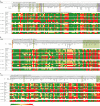Commensal streptococci serve as a reservoir for β-lactam resistance genes in Streptococcus pneumoniae
- PMID: 25845880
- PMCID: PMC4432199
- DOI: 10.1128/AAC.00429-15
Commensal streptococci serve as a reservoir for β-lactam resistance genes in Streptococcus pneumoniae
Abstract
Streptococcus pneumoniae is a leading cause of pneumonia, meningitis, septicemia, and middle ear infections. The incidence of S. pneumoniae isolates that are not susceptible to penicillin has risen worldwide and may be above 20% in some countries. Beta-lactam antibiotic resistance in pneumococci is associated with significant sequence polymorphism in penicillin-binding proteins (PBPs). Commensal streptococci, especially S. mitis and S. oralis, have been identified as putative donors of mutated gene fragments. However, no studies have compared sequences of the involved pbp genes in large collections of commensal streptococci with those of S. pneumoniae. We therefore investigated the sequence diversity of the transpeptidase region of the three pbp genes, pbp2x, pbp2b, and pbp1a in 107, 96, and 88 susceptible and nonsusceptible strains of commensal streptococci, respectively, at the nucleotide and amino acid levels to determine to what extent homologous recombination between commensal streptococci and S. pneumoniae plays a role in the development of beta-lactam resistance in S. pneumoniae. In contrast to pneumococci, extensive sequence variation in the transpeptidase region of pbp2x, pbp2b, and pbp1a was observed in both susceptible and nonsusceptible strains of commensal streptococci, conceivably reflecting the genetic diversity of the many evolutionary lineages of commensal streptococci combined with the recombination events occurring with intra- and interspecies homologues. Our data support the notion that resistance to beta-lactam antibiotics in pneumococci is due to sequences acquired from commensal Mitis group streptococci, especially S. mitis. However, several amino acid alterations previously linked to beta-lactam resistance in pneumococci appear to represent species signatures of the donor strain rather than being causal of resistance.
Copyright © 2015, American Society for Microbiology. All Rights Reserved.
Figures




References
-
- Henriques-Normark B. 2007. Molecular epidemiology and mechanisms for antibiotic resistance in Streptococcus pneumoniae, p 269–290. In Hakenbeck R, Chhatwal GS (ed), Molecular biology of streptococci. Horizon Press, Wymondham, Norfolk, United Kingdom.
-
- Anonymous. 2013. Centers for Disease Control and Prevention. Streptococcus pneumoniae. Active Bacterial Core Surveillance report, Emerging Infections Program Network 2013. http://www.cdc.gov/abcs/reports-findings/survreports/spneu13.pdf.
Publication types
MeSH terms
Substances
LinkOut - more resources
Full Text Sources
Molecular Biology Databases
Research Materials
Miscellaneous

